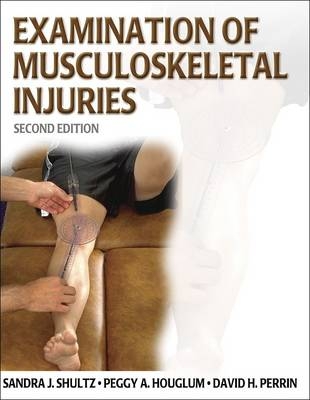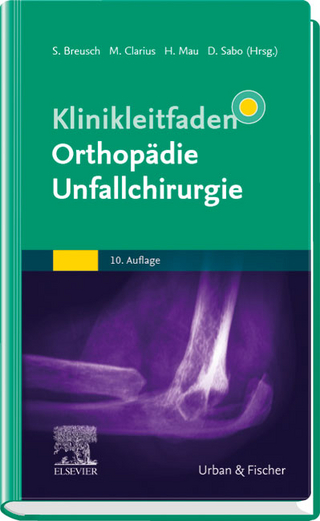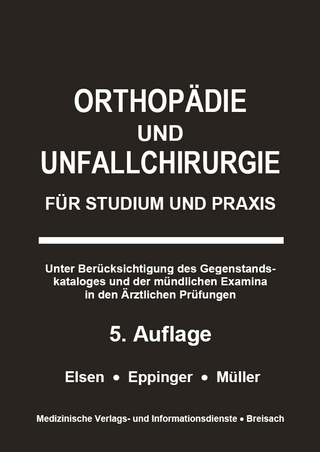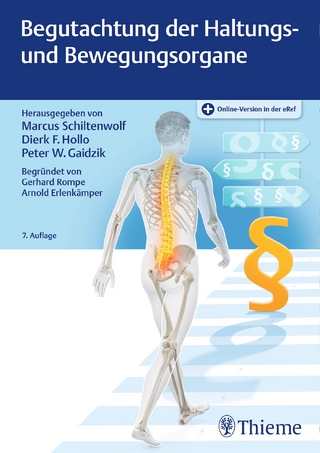
Examination of Musculoskeletal Injuries
Human Kinetics Publishers (Verlag)
978-0-7360-5138-5 (ISBN)
- Titel erscheint in neuer Auflage
- Artikel merken
The text, part of Human Kinetics' Athletic Training Education Series, is an indispensable reference for athletic trainers and other health professionals who spend much of their time caring for injuries related to physical activity and must have a solid background in recognition and examination to do so effectively. Significantly expanded, the new edition now contains 23 chapters, ten more than the first edition, that provide a broad and firm understanding of general examination principles and techniques, recognition and examination of injuries and conditions specific to each body region, and general medical conditions that you will likely encounter in the physically active.
Examination of Musculoskeletal Injuries, Second Edition, is divided into three well-organized parts. The first part reviews in detail the general principles and foundational skills for each component of the injury examination. In addition, it includes new content related to general evaluation techniques for goniometric measurement, manual muscle testing, upper and lower quarter screens, posture, and gait.
The second part considers examination strategies for the various regions of the body, including each major joint (e.g. elbow, knee, etc); cervical, thoracic, and lumbar spines; head and face; and abdomen and thorax. Each chapter is devoted to a specific body region and is broken down into four segments: functional anatomy and biomechanics; injuries specific to that body region; objective tests including structures for palpation, range of motion testing, strength testing, and special tests; and assessment strategies focusing on acute versus chronic injuries.
In the third part, three chapters address general medical conditions that allied health professionals are likely to see in physically active clients and patients. The topics are discussed according to the body systems presented in Athletic Training Educational Competencies (National Athletic Trainers' Association, 1999). Because examinations of these conditions usually are the physician's responsibility and require diagnostic tests to identify, the text prepares readers to make appropriate referrals based on a patient's history and their own observations.
The new edition includes many additional features for students, professionals, and instructors:
-More than 150 illustrations, 500 photographs, and 110 tables that enable the reader to correctly comprehend the material
-A student Web site that includes printable checklists for every phase of injury examination, along with superb full-color photographs of skin ailments that will enhance the reader's ability to correctly identify the disorder
-Pedagogical aids that will assist in learning and retention of crucial material, including chapter objectives and summaries; "warning boxes" and "reminder boxes" highlighting techniques and knowledge crucial to avoiding further injury, permanent disability, or even death; key terms; review and critical thinking questions; a glossary; and references and bibliographical material
-An instructor guide and test bank with case studies, course projects, chapter worksheets, sample test questions, and a sample course syllabus to help teachers prepare lectures and exams and organize courses and
-A presentation package, heavily weighted toward photographs of objective tests and easily adapted to each instructor's lecture content and style.
Human Kinetics' Athletic Training Education Series contains five outstanding textbooks, each with its own superb supporting instructional resources. Featuring the work of respected athletic training authorities, the series was created to parallel and expound on the content areas established by the National Athletic Trainers' Association (NATA) Education Council. Examination of Musculoskeletal Injuries, Second Edition, addresses the content areas of Pathology of Injury and Illness; Assessment and Evaluation; and General Medical Conditions and Disabilities.
To learn more about the books in this series, visit the Athletic Training Education Series Web site at www.HumanKinetics.com/AthleticTrainingEducationSeries
Sandra Shultz has been a certified athletic trainer since 1984. She has a broad clinical perspective with professional experience at college, high school and clinical settings, as well as at Olympic and International levels. Peggy Houglum has more than 30 years of experience in rehabilitation and providing athlete care. David Perrin was editor-in-chief of the Journal of Athletic Training from 1996 to 2004 and the founding editor of the Journal of Sport Rehabilitation.
Part I: Principles of ExaminationChapter 1. Anatomical Nomenclature and Injury Classifications-Anatomical Reference Terminology-Injury Classifications-Closed (Unexposed) Wounds-Open (Exposed) Wounds-Summary-Review Questions-Critical Thinking Questions-Cited References-Additional ResourcesChapter 2. Principles of Assessment: An Overview-Examination Components-Documentation of Your Examination-Summary-Review Questions-Critical Thinking Questions-Cited References-Additional ResourcesChapter 3. Taking a History-Information to Be Gained From the History-Situation-Specific History: Depth of Inquiry-Summary-Review Questions-Critical Thinking Questions-Cited Reference-Additional ResourcesChapter 4. Observation-System of Observational Assessment-Details of Specific Observation-Summary-Review Questions-Critical Thinking Questions-Cited References-Additional ResourcesChapter 5. Palpation-General Principles-Structures to Palpate-Palpation Strategies-Summary-Review Questions-Critical Thinking Questions-Cited References-Additional ResourcesChapter 6. Range of Motion-Goals and Purposes-Normal Range of Motion-Prerequisites for Successful ROM Examination-Measuring Range of Motion-Accessory Movement Examination-Special Tests: Ligament and Capsule Stress Tests-Summary-Review Questions-Critical Thinking Questions-Cited References-Additional ResourceChapter 7. Examination of Strength-Muscle Contraction-Goals and Purposes of Strength Examination-Methods of Strength Examination-Manual Strength Examination-Instrumented Strength Examination-Summary-Review Questions-Critical Thinking Questions-Cited References-Additional ResourcesChapter 8. Examination of Neurological Status-Functional Neuroanatomy-Region Specific Neurological Examination-Summary-Review Questions-Critical Thinking Questions-Cited References-Additional ResourcesChapter 9. Examination of Cardiovascular and Respiratory Status-Functional Anatomy and Physiology-Examination of Cardiovascular and Respiratory Status-Cardiovascular Compromise-Summary-Review Questions-Critical Thinking Questions-Additional ResourceChapter 10. Putting It All Together: General Examination Strategies-On-Site Emergent Examination-Immediate Post Acute Examination-Clinic Examination-Summary-Review Questions-Critical Thinking Questions-Additional ResourcesPart II: Region Specific Examination StrategiesChapter 11. Cervical and Upper Thoracic-Functional Anatomy-Injuries to the Cervical and Upper Thoracic Spine-Objective Tests-Injury Assessment Strategies-Summary-Review Questions-Critical Thinking Questions-Cited References-Additional ResourcesChapter 12. Shoulder and Arm-Functional Anatomy-Injuries to the Shoulder Complex and Upper Arm-Objective Tests-Injury Examination Strategies-Summary-Review Questions-Critical Thinking Questions-Cited References-Additional ResourcesChapter 13. Elbow and Forearm-Functional Anatomy-Injuries of the Elbow and Forearm-Objective Tests-Injury Assessment Strategies-Summary-Review Questions-Critical Thinking Questions-Cited References-Additional ResourcesChapter 14. Wrist and Hand-Functional Anatomy-Injuries to the Wrist and Hand-Objective Tests-Injury Examination Strategies-Summary-Review Questions-Critical Thinking Questions-Cited References-Additional ResourcesChapter 15. Lower Thoracic and Lumbar Spine-Functional Anatomy-Injuries to the Lower Thoracic and Lumbar Spine-Objective Tests-Injury Examination Strategies-Summary-Review Questions-Critical Thinking Questions-Cited Reference-Additional ResourcesChapter 16. Leg, Ankle, and Foot-Functional Anatomy-Injuries to the Leg, Ankle, and Foot-Objective Tests-Injury Examination Strategies-Summary-Review Questions-Critical Thinking Questions-Cited References-Additional ResourcesChapter 17. Knee and Thigh-Functional Anatomy-Injuries to the Knee and Thigh-Objective Tests-Injury Examination Strategies-Summary-Review Questions-Critical Thinking Questions-Cited References-Additional ResourcesChapter 18. Hip, Pelvis, and Groin-Functional Anatomy-Injuries to the Hip, Pelvis, and Groin-Objective Tests-Injury Examination Strategies-Summary-Review Questions-Critical Thinking Questions-Cited and Additional ResourcesChapter 19. Head and Face-Functional Anatomy-Injuries to the Head and Face-Objective Tests-Injury Examination Strategies-Summary-Review Questions-Critical Thinking Questions-Cited References-Additional ResourceChapter 20. Thorax and Abdomen-Functional Anatomy-Injuries to the Thorax and Abdomen-Objective Tests-Injury Assessment Strategies-Summary-Review Questions-Critical Thinking Questions-Cited References-Additional ResourcesPart III: Recognition of General Medical ConditionsChapter 21. EENT and Cardiorespiratory Conditions-Eyes, Ears, and Mouth-Respiratory System-Cardiovascular System-Viral Syndromes-Summary-Review Questions-Critical Thinking Questions-Cited References-Additional ResourcesChapter 22. Digestive, Endocrine, Reproductive, and Urinary Conditions-Endocrine System-Digestive System-Eating Disorders-Sexually Transmitted Diseases and Diseases Transmitted by Body Fluid-Genitourinary Tract and Organs-Gynecological Disorders-Summary-Review Questions-Critical Thinking Questions-Cited References-Additional ResourcesChapter 23. Musculoskeletal, Nervous, and Integumentary Conditions-The Skin-Musculoskeletal-Neurological Disorders-Systemic Diseases-Summary-Review Questions-Critical Thinking Questions-Cited References-Additional Resources
| Reihe/Serie | Athletic Training Education S. |
|---|---|
| Zusatzinfo | 714 illustrations |
| Verlagsort | Champaign |
| Sprache | englisch |
| Maße | 216 x 279 mm |
| Themenwelt | Medizinische Fachgebiete ► Chirurgie ► Unfallchirurgie / Orthopädie |
| Medizin / Pharmazie ► Medizinische Fachgebiete ► Sportmedizin | |
| ISBN-10 | 0-7360-5138-4 / 0736051384 |
| ISBN-13 | 978-0-7360-5138-5 / 9780736051385 |
| Zustand | Neuware |
| Informationen gemäß Produktsicherheitsverordnung (GPSR) | |
| Haben Sie eine Frage zum Produkt? |
aus dem Bereich


